On September 29, 1864, Black soldiers serving in the U.S. Colored Troops (USCTs) led an assault against Confederate defenses protecting Richmond during the Battle of New Market Heights. New Market Heights was part of the larger Battle of Chaffin’s Farm. It included fighting at Fort Harrison, Fort Gilmer, and Laurel Hill. During this battle, two brigades of the USCTs proved their heroism, fought courageously and captured New Market Heights. Fourteen soldiers from the USCTs earned Medals of Honor for gallantry.
In September 1864, Lt. Gen. Ulysses S. Grant approved a plan to send Union Major General Benjamin F. Butler’s Army of the James to break through Confederate defenses guarding the Confederate capital of Richmond. Included in the 20,000 Union troops were some 4,500 Black soldiers fighting in the USCTs.
The offensive consisted of a two-pronged attack, which called for Major General Edward Ord’s XVIII Corps to cross the James River at Aiken’s Landing and move toward the Confederate-held Fort Harrison. Fort Harrison was later captured and renamed Fort Burnham.
The second prong, and focus here, is Maj. Gen. David B. Birney’s X Corps, and Brigadier General Charles J. Paine’s USCT regiments (who were detailed from the XVIII Corps but operating with the X Corps that morning).
At dawn on September 29th, Paine’s division, spearheaded by the 4th and 6th USCTs (Third Brigade), crossed the James River at Deep Bottom Landing. Their objective was to take New Market Heights. That would give them control of New Market Road, which led directly to Richmond. As they advanced towards New Market Road, the division came under heavy fire from Confederate earthwork defenses. After heavy losses of half their forces, the Union brigade withdrew.
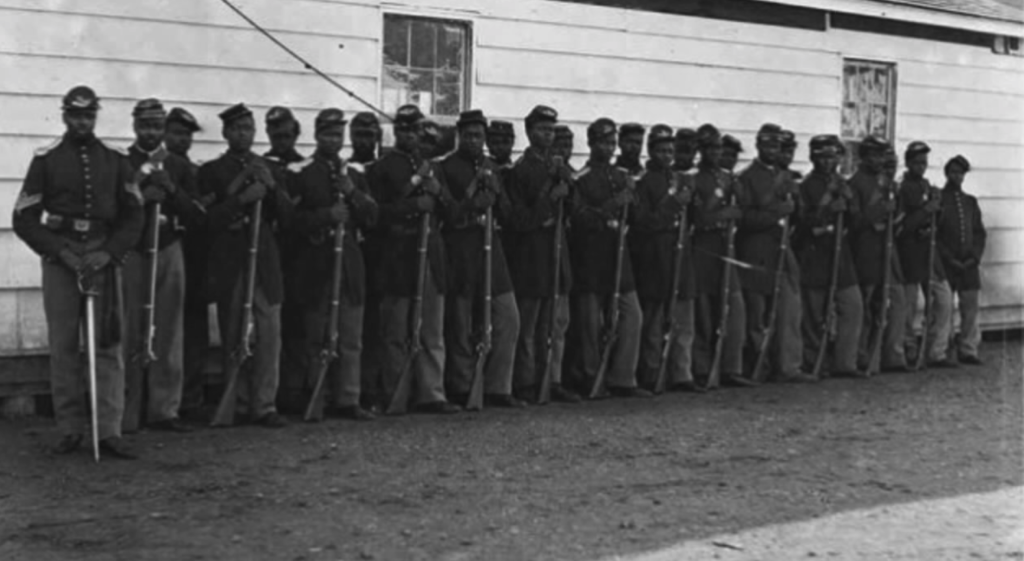
Next, the Second Brigade, consisting of the 5th, 36th, and 38th USCTs, advanced. They also engaged in brutal fighting and lost more than 1/3 of their forces before finding an opening and bursting through the Confederate line. They advanced up New Market Heights while the Confederates retreated toward Richmond.
When the battle was over, the Union Army suffered an estimated 3,300 casualties for soldiers fighting north of the James River on September 29-30. Confederate casualties numbered 1,750. Soldiers from the USCTs proved their mettle. Over and over, as color-bearers and white commanding officers were shot down, Black soldiers stepped up to retrieve the colors and lead the troops. During the entire Civil War, only 16 Black soldiers received the Medal of Honor. Fourteen of those were awarded to soldiers after the Battle of New Market Heights.
Following are short bios for each of the 14 members of the USCTs awarded Medals of Honor for their actions that day:
William H. Barnes was born in St. Mary’s County, Maryland, and enlisted in the 38th Regiment of the USCT, Company G, on July 2, 1864, at age 19. He was 5’4” and listed his occupation as a farmer. During the Battle of New Market Heights, Barnes was “among the first to enter the enemy’s works; although wounded.” Barnes was later promoted to Sergeant and traveled to Indianola, Texas, with his regiment. While in Texas, Barnes contracted tuberculosis and died in Indianola on Christmas Eve in 1866. He was officially mustered out of service in January 1867.
Powhatan Beaty was born in Richmond, Virginia, on October 8, 1837, and was formerly enslaved. At some point, he became a freedman and moved to Cincinnati, where he studied acting. Beaty enlisted in the 5th USCTs, Company G, on June 9, 1863, in Ohio. He served as a 1st Sergeant. During the Battle of New Market Heights, Beaty raced to retrieve the flag from a fallen color-bearer. Finding the officers all dead or wounded, he took command of his company and gallantly led it.” He mustered out of service on September 20, 1865, at Carolina City, North Carolina.
James H. Bronson was born in Indiana County, Pennsylvania. His military records show that he was 25 years old and mixed race. Bronson had grey eyes, dark hair, 5’9”, and was employed as a barber when he enlisted July 4, 1863, in Trumbull County, Ohio. He served in the 5th USCTs, Company D. He was later promoted to 1st Sergeant. During the Battle of New Market Heights, Bronson took charge of his company and led them throughout the day after his company officers were all killed or wounded. Following the battle, Bronson requested to have his rank reduced so he could join the regimental military band. He was mustered out on September 20, 1865, at Carolina City, North Carolina.
Christian A. Fleetwood was born a freeman in Baltimore, Maryland, and enlisted in the 4th USCTs on August 11, 1863. Before he enlisted, Fleetwood worked as a clerk. He was 23 years old, with a brown complexion, black eyes, black hair, and stood 5’4.5” tall. Fleetwood received a promotion to Sergeant Major. At the time, this was the highest rank a Black soldier could attain in the U.S. Army. At the Battle of New Market Heights, Fleetwood “Seized the colors after two color bearers had been shot down, and bore them nobly through the fight.” Following the war, Fleetwood worked as a clerk in the War Department.
James Gardiner served as a private in the 36th USCT, Company I. He was born in Gloucester, Virginia, and worked as an oysterman. He enlisted on September 15, 1863, when he was 19 years old and 5’7” tall. During the Battle of New Market Heights, Gardiner “rushed in advance of his brigade, shot at a rebel officer who was on the parapet cheering his men, and then ran him through with his bayonet.” The day after the battle, Gardiner was promoted to the rank of Sergeant. He was mustered out of service at Brazos de Santiago, Texas, on September 20, 1866.
James H. Harris was born in 1828 in St. Mary’s County, Maryland. When he was 36 years old, he enlisted in the 38th USCTs, Company B. He was a farmer and described as 5’10” tall with a black complexion, black eyes, and black hair. He was promoted to corporal on July 25, 1864, and then to sergeant on September 29, 1864 – the same day as the Battle of New Market Heights. During the battle of New Market Heights, Harris was wounded and later awarded a Medal of Honor for “gallant conduct.” His muster roll records show he spent September and October in the hospital and returned to duty in November 1864. On July 1, 1865, his rank was reduced to private, although no reason is given in his records. Harris mustered out of service on January 25, 1867, at Indianola, Texas.
Thomas R. Hawkins was born in 1840 in Cincinnati, Ohio. According to his obituary, Hawkins “escaped the Southern lines in 1863” and as soon as he reached the North, knelt down and kissed the Union soil. He vowed to do anything he could for the cause of liberty. He enlisted in the 6th USCTs in Philadelphia and entered service as a Sergeant Major. He was wounded in the arm early in his service but quickly rejoined his regiment when the wound healed. During the Battle of New Market Heights, Hawkins was shot through the shoulder, hip, and foot, but managed to rescue the regimental colors. After the war, Hawkins was active in the Temperance Society in Washington, D.C. This letter found in the Freedmen’s Bureau Record Collection on Ancestry® shows Hawkins asking for the use of a room to hold a Temperance Society meeting in 1867. The wounds Hawkins received during the Battle of New Market Heights eventually led to his death. He was awarded a Medal of Honor on February 8, 1870, but died less than three weeks later, on February 28, 1870, in Washington, D.C.
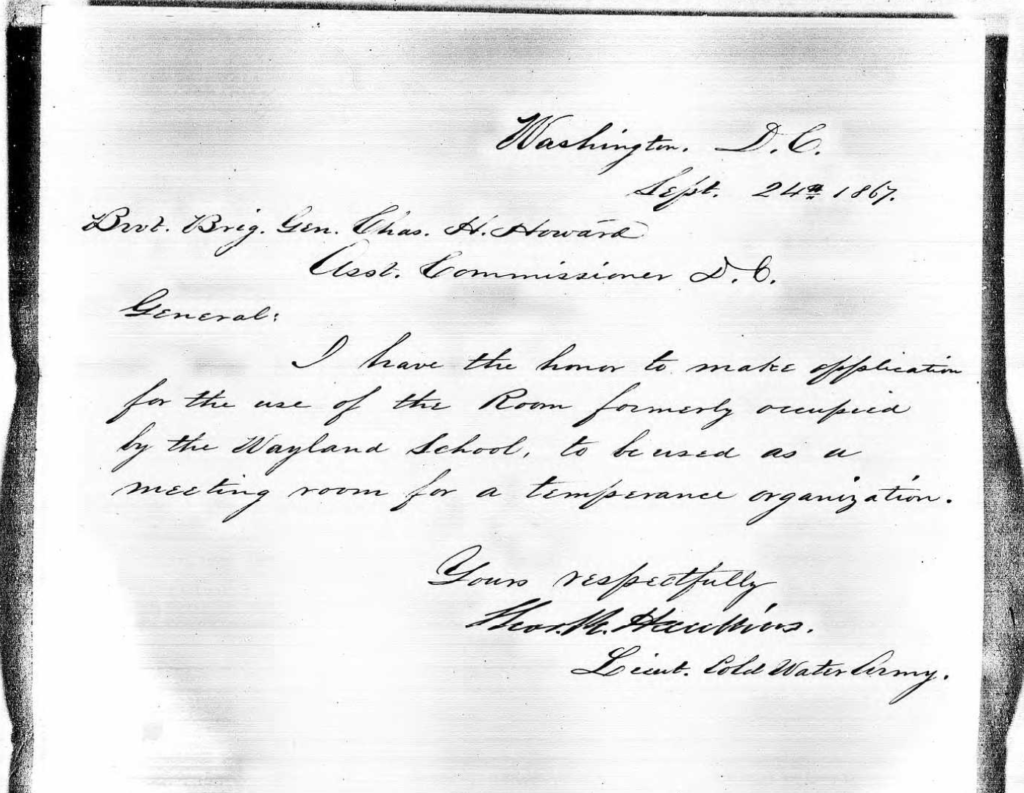
Alfred B. Hilton was one of 14 children born to parents who were formerly enslaved. In August 1863, Alfred and his two brothers joined the 4th USCTs, Company H. Hilton was 21 years old and listed his occupation as a farmer when he enlisted with the rank of sergeant. During the charge on New Market Heights, Sgt. Hilton retrieved the regimental colors after the color bearer was wounded. Hilton was also wounded and struggled forward until he could no longer continue. Hilton was admitted to a military hospital at Fortress Monroe where his right leg had to be amputated below the knee. He eventually died from his battle wounds on October 21, 1864. According to Freedmen’s Bureau Records, Hilton’s parents, Isaac and Harriett, received a $90 pension payment in 1868.
Milton M. Holland was born in Austin, Texas in 1844. When he was 18, he enlisted as a Sergeant Major in the 5th USCTs, Company C, at Athens, Ohio. He was a shoemaker who stood 5’8” tall. His Medal of Honor citation states, “Took command of Company C, after all the officers had been killed or wounded, and gallantly led it.” Despite acting as an officer during combat, Holland was refused an officer’s commission because of race. Following the war, Holland moved to Washington, D.C., where he worked as a government clerk. When he died on May 15, 1910, his valuable estate consisted of “thirty-two acres of land, more or less, improved by a twelve-room frame dwelling house, all modern improvements: good barn, stable and carriage houses and all other necessary outbuildings.”
Miles James was born in 1829 in Princess Anne County, Virginia. He enlisted in the 36th USCTs, Company B, on November 16, 1863. At the time, he was 34 years old and worked as a farmer. During the Battle of New Market Heights, he was severely wounded in the left arm, necessitating an amputation right on the battlefield. He was awarded the Medal of Honor, the citation reading, “After having his arm so badly mutilated that immediate amputation was necessary, [he] loaded and discharged his piece with one hand, and urged his men forward…” While recovering in the hospital, Brig. Gen. Alonzo G. Draper, commander of the 36th USCTs, wrote a letter saying that James requested that he not be discharged. He wished to remain in the service. Draper urged military officials to grant the request. Draper wrote, “He is one of the bravest men I ever saw… and a model soldier. He is worth more with his single arm, than half a dozen ordinary men.” James was discharged by order of Surgeon’s Certificate for disability on October 13, 1865, at Brazos de Santiago, Texas. In the 1870 Census, James was living in Norfolk with his wife Sarah and three children working as a shoemaker. He died on August 28, 1871, in Norfolk, Virginia.
Alexander Kelly was born near Saltsburg in Indiana County, Pennsylvania, on April 7, 1840. He enlisted in the 6th USCTs, Company F, at Allegheny, Pennsylvania, on August 24, 1863. He was a 23-year-old coal miner and enlisted as a substitute for his brother Joseph Kelly after Joseph was drafted. Joseph had a large family dependent upon him for support, so Alexander took his place. Kelly saw fighting at Petersburg, Dutch Gap, and at the Battle of New Market Heights. During that battle, when the color bearer had been shot down, he gallantly seized the colors, rallied the survivors, and led them in a charge on the breastworks of the enemy. Kelly died on June 19, 1907.
Robert A. Pinn was born a freeman on March 1, 1843, in Stark County, Ohio. His father escaped from slavery and fled to Ohio at the age of eighteen. Pinn attempted to enlist in the Union Army at the beginning of the war but was denied because of his race. Instead, Pinn joined the 19th Ohio Infantry in 1861 as a civilian worker. He fought in the Battle of Shiloh despite his non-military status. After President Lincoln opened the way for Black men to serve, Pinn enlisted in the USCTs 5th USCTs, Company I, in 1863. During the Battle of New Market Heights, Pinn served with gallantry at Fort Harrison. Later that same day, he was severely wounded at Fort Gilmer and hospitalized in Portsmouth, Virginia. Following the war, Pinn returned to Ohio where he studied law and became the first Black lawyer in Massillon County. He was active in the GAR and became the first Black Commander of Hart Post 134. He died in his hometown of Massillon, Ohio, in 1911.
Edward Ratcliff was born enslaved on a farm in James City County, Virginia, on February 8, 1835. Ratcliff, along with 37 other enslaved individuals, worked the lands for slave owner Alexander Hankins. When the Civil War broke out, Hankins formed a Confederate military unit, called the James City Artillery. In 1863, President Lincoln issued the Emancipation Proclamation, and one year later, 29-year-old Ratcliff walked away from the Hankins farm to enlist in the 38th USCT. During the Battle of New Market Heights, Ratcliff took command after his commanding officer was killed. Ratcliff became the first Union soldier to enter the enemy’s defenses and stand inside their fortification. He was promoted to 1st Sergeant, and later to Sergeant Major. Ratcliff was mustered out of service at Indianola, Texas, on January 25, 1867. He died on March 10, 1915, in York County, Virginia.
Charles Veal was born in 1838 in Portsmouth, Virginia. He enlisted in the 4th USCTs, Company D, in July 1863. At the time, he was a 25-year-old fireman. During the Battle of New Market Heights, the 4th and 6th USCTs were the first to advance. Christian Fleetwood, a fellow Medal of Honor recipient, later recalled the battle. He said that a color guard consisting of 14 men (two sergeants and twelve corporals) advanced on the field. One of them was Veal. They came under fire, and Veal was the only one left standing. He was awarded the Medal of Honor for gallantry when he “seized the national colors, after two color bears had been shot down close to the enemy’s works, and bore them through the remainder of the battle.” He died July 27, 1872, in Hampton City, Virginia.
If you would like to learn more about the Battle of New Market, visit Fold3® today. Also, explore the new Freedmen’s Bureau Records Collection for free on Ancestry® for additional records related to the USCTs.

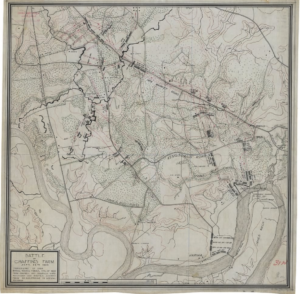
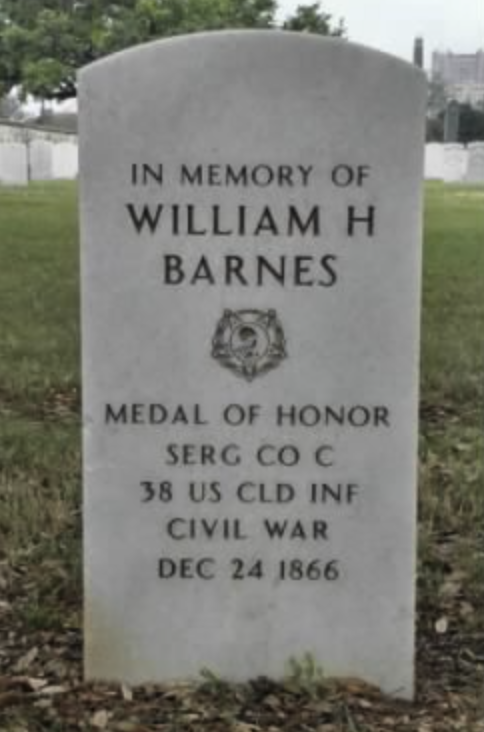
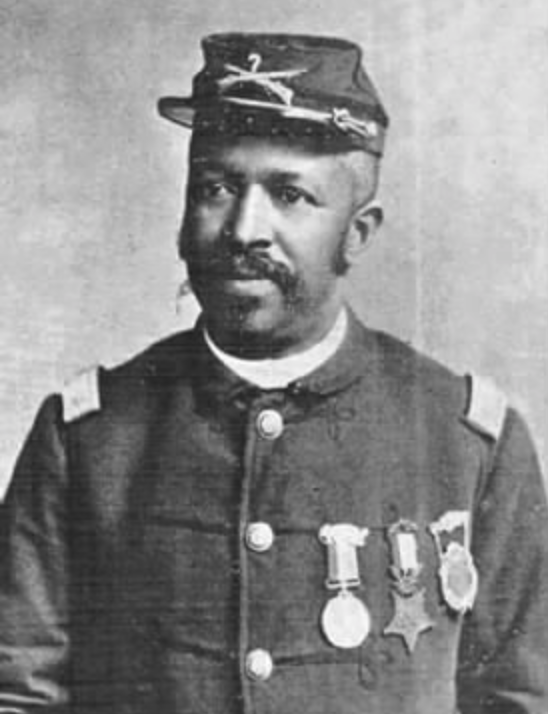
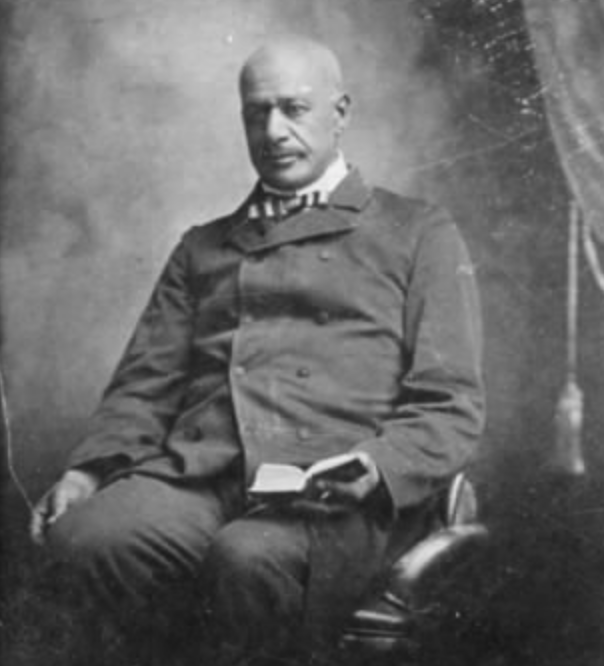
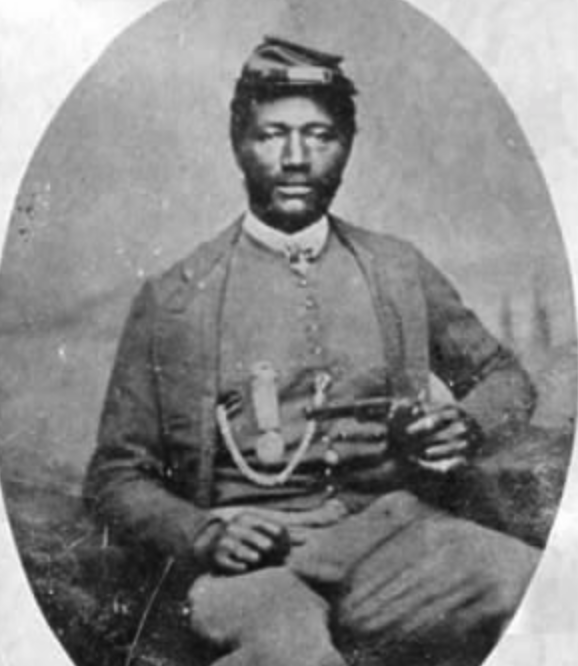

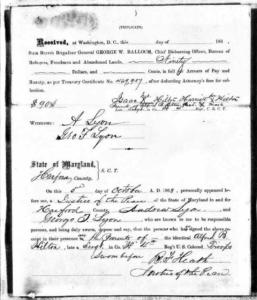
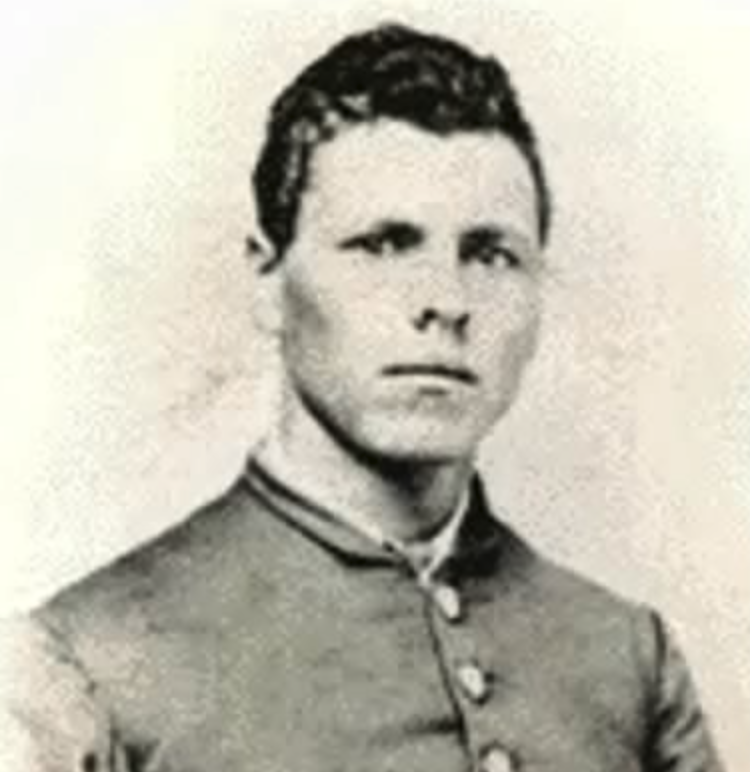
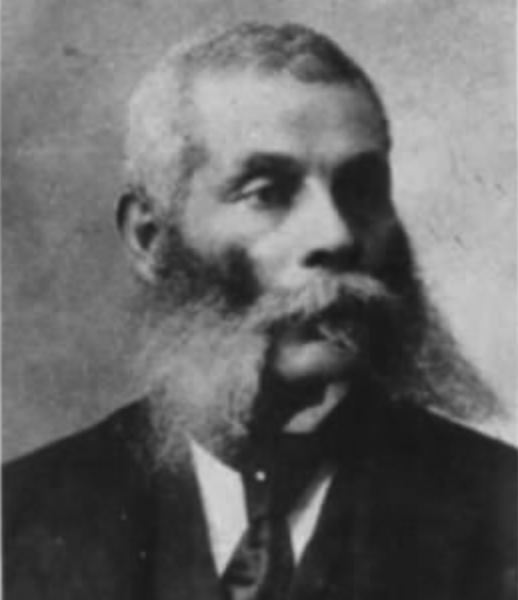
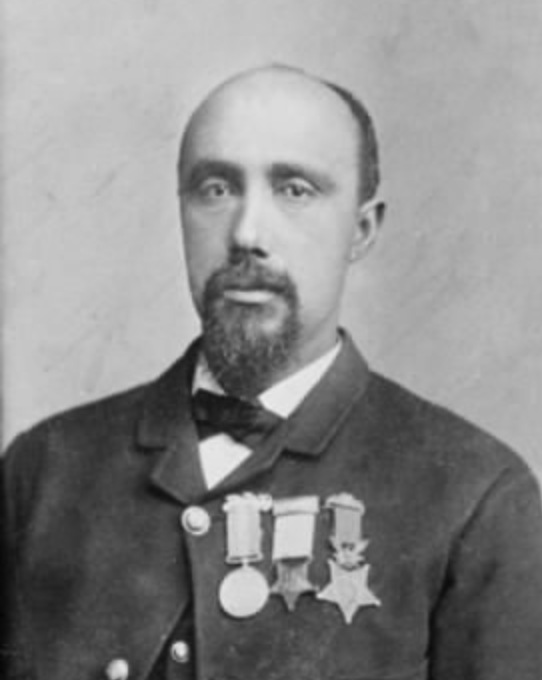

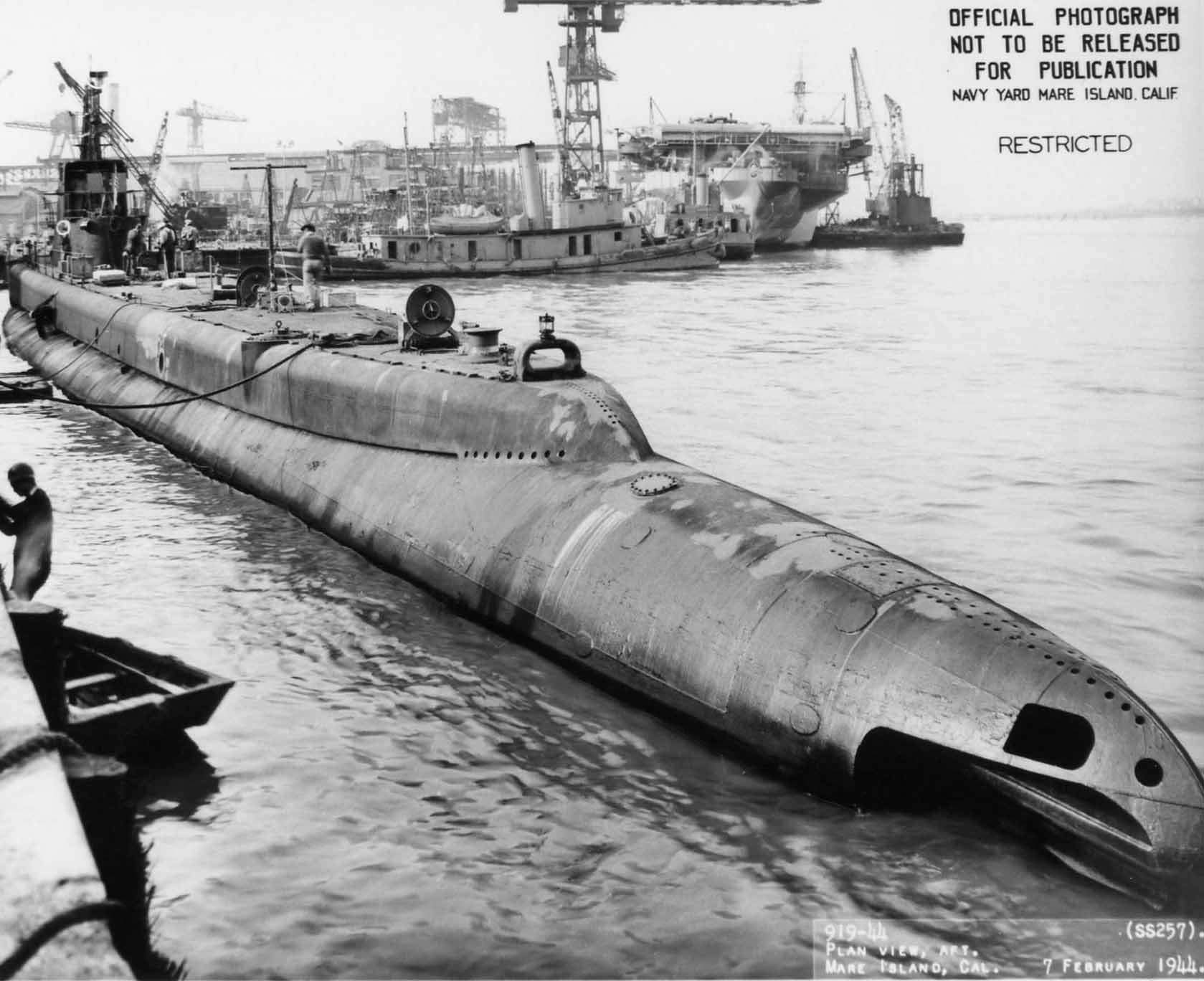


I understand this is just a summary of these gallant soldiers awarded the Medal of Honor. However, because of the brevity, it is difficult to understand what actions were deserving of the award. I see a lot who picked up the flag or took command when necessary. No disrespect, but that is not above and beyond the call of duty, that is expected. I will have to research each of these gentlemen to find out more.
These brave men volunteered to take up arms for a government that did not consider them citizens until the 14th amendment was ratified in 1868. They had been devalued as people ever since the US constitution was written and declared only 60% of enslaved black people merited representation in Congress (Article 1, Section 2) . When they enlisted to fight for the Union, they faced a brutal enemy who hated them because of the color of their skin. Despite the shameful way they had been treated they took up arms and fought valiantly on behalf of the US government. I think this more than meets the qualification of “above and beyond the call of duty.”
Exactly Linda York!
I think one should consider that many confederate units routinely executed captured and wounded negro troops. Very few were taken prisoner and fewer still ever repatriated after the war.
I am somewhat surprised that an even greater number were not recognized for heroism
Why assume they are not worthy? Why not assume that those officers at the time knew what they were doing when they recommended them for medals?
Sir, with all due respect I vehemently disagree. This is not about color, unless you your self were there during the Civil War, came from slavery and acted on your own volition as from a subordinate race facing odds from all directions you are not qualified to judge this matter. My ancestors fought on both sides and pride judges the living only.
I disagree. To begin with, you apparently do not know that in the Civil War the criterion of acting “above and beyond the call of duty” did not exist. The Army’s Medal of Honor was intended for “such non-commissioned officers and privates as shall most distinguish themselves by their gallantry in action….” https://en.wikipedia.org/wiki/Medal_of_Honor#Evolution_of_criteria. Soldiers on both sides knew that the flag bearers had a very important task, to carry the flag to show in the smoke and noise when shouted orders could not be heard where the front of the regiment was, whether it was advancing or retreating. The color guard members often volunteered for these jobs, although they knew that they would be the prime targets of the enemy. Shooting the enemy’s flag bearer was an important military objective, because when the flag fell it signaled an important casualty had been suffered and perhaps the attack had been stalled. Being caught in the open was extremely hazardous if the unit was not moving forward. So others would pick up the flag to rally the attack. They knew their chances of being shot were higher than the chances of all other individual soldiers. The flags were, in a sense, sacred to the troops because carrying the flag to victory signified that all the horrible sacrifices suffered in the attack had been worth the effort. Losing the flag was a disgrace, especially if it was captured by the enemy. Taking the enemy’s flag was the highest symbol of gallantry and military accomplishment for the individual soldier. These factors applied to both sides. These black soldiers all met the standard of gallantry in action, and taking such selfless steps to rally the regiments by standing themselves out in front before the enemy would qualify them for the Medal of Honor under any standard
If u or ur parents were born enslaved and u decide to use ur freedom to fight for this country, u deserve honor PERIOD
You have to remember that the Civil War was a far different time, and place, and that what we in the present time would not consider “heroic,” actually was. Battlefield command at that time centered around the Standard Bearers, the men of the organization were often scattered across the field, and the Commanders often gave orders via the positioning of the Flag (or Flags.) The Standard Bearers were also a group that the enemy would be able to see and fire upon, possibly more effectively, than the soldier not carrying anything distinguishing on the field. Shooting the Standard Bearers was a method of disorganizing the unit facing you. To grab up the Standards from a fallen Bearer meant that you were putting a target on yourself.
Also notice that several of these men not only took the Standard, but were also leading the troops because their officers were killed or wounded.
Kind of a personal note: it is somewhat akin to Army Medics and Navy Corpsmen learning very quickly in Vietnam that wearing their “Aidman” Brassards, a white strip of cloth with a red cross on it, around their arms, were sure to make them targets for the VC and NVA.
Color bearers were considered prime targets for enemy fire during the Civil War. Wherever the colors were, the Regiment was. If the colors fell or were captured the Regiment usually disintegrated on the spot. Being a color bearer or guard was tantamount to a suicide assignment, but men volunteered willingly for the honor, for they would be the keepers of the Regiment’s honor and its battle prowess. If they faltered the whole unit faltered. Taking up the colors from a fallen bearer and pressing forward was an act of courage that would merit fan mail from John Wayne, Audie Murphy, and Rambo. Capturing an enemy’s colors was just as brutal, if not a bit more so. If you, an individual, managed to get close enough to those colors to lay a hand on them you had single-handedly fought your way through about 15 or so blood-crazed maniacs. Now you had to wrench them away from someone who would rather die than lose them. AND whatever friends were still alive around him. Now, you had to get away, colors in hand. And live. As a general rule, a unit only lost its colors if it was absolutely overwhelmed and about 70-90% of the men dead or wounded. As for taking command when the officers were killed, you must remember that enlisted troopers were not thought capable of acting in an officer’s role. Further, the prevailing opinion was that it was the officers who inspired or drove the ranks forward, and without them a unit of troops would just be so much cannon fodder. Today we have a different social construct to our military forces.
It was much, much more than that. I did my MA thesis on this engagement and to say they earned it is an understatement. It is unimaginable what they charged through that day. It was an impenetrable bog of earthworks, parapets, slashing, and swamp, all under the relentless barrage of shot and cannon. To add to their courage, Butler had ordered that no cap be removed before they reached the Confederate fortifications. In essence, they marched into hell without returning fire, armed with little more than axes to cut at the slashing. The engagement was meant to be a test of the staying power and courage of the newly incorporated Black soldier, and boy did they deliver. By the end of the 30th, they had pushed to within one mile of Richmond, the closest any Union element had come to the Confederate capital up to that point. If you’re interested, there is a short read by Historian James Price called The Battle of New Market Heights: Freedom Will be Theirs by the Sword. It does a fairly good job to give details while being efficient with its word count.
I disagree with your comments. There are many soldiers who chose not to pick up the colors because of it making them more of a target than just advancing towards enemy lines. Obviously you’re not familiar with the carrying or bearer of the colors. One must protect it, carry it, and see to its planting upon grounds seized during battle. This means planting it in the ground while fighting and engaging enemies in hand to hand combat, as well as dodging canon fire and all kinds of scrap metals fired as well. It doesn’t matter what the medal criteria was during the Civil War. Their heroism and gallant actions led to capture of the fort, while forcing confederate soldiers to retreat. That’s more than enough!
With all due respect, Mr. Rosenblatt, wouldn’t it make sense to “research each of these gentlemen to find out more” BEFORE casting aspersions?
Norman Rosenblatt: My hope is that due to your controversy in the standards of heroism in the heat of battle and underfire with a barrage of lead bullets, Cannonballs and other ballistics raining down on the battlefield that a man’s flesh occupies, that you diligently research the war archives and will find that picking up the battle standards during a deadly charge while exposed without cover towards a enemy is the most heroic courageous action one can display for the moral and rallying of comrades troops in arms to continue to move forward in the face of death and being mamed for life and your fellow comrades are encouraged by your brave actions is deserving of recognition.
Imagine if you put yourself in their shoes.
How about you do your research under a hail of bullets as people around you are being torn apart as they are hit. Then you can question their bravery.
The colours would be a centre point of fire from both rifle and field gun. To say it would be expected is an understatement of the bravery to expose yourself to enemy fire and act in a direction towards the enemy to rouse the troops. The bravery is undeniable.
Loosing ones flag at that time was a terrible disgrace for both sides. Also remember that the standards for the award have been modified over the years and are much more stringent now then they were back during the Civil War.
Why? What is so important that you need to research the details of the award?
” the US constitution was written and declared only 60% of enslaved black people merited representation in Congress (Article 1, Section 2) ”
Linda York, when we look at that with today’s eyes, it is easy to miss the motivation behind that particular inclusion – not to deny that for many if not most whites of that time did not consider enslaved POC worthy of citizenship. However, this came about in the Constitution as a maneuver to restrain the power of the slave holding states. If each slave had been counted as a “whole person” for the purposes of apportioning representation in Congress (while those slaves would not have ANY rights of citizens, including being “represented”), those slave holding states, and their agendas (primarily maintaining slavery and the industries dependent upon slavery) would have dominated Congress. The non-slave states recognized the danger of this and forced through this compromise.
During the Civil War and even later, the Medal of Honor was the only award presented for heroism. As such the actions of the soldiers and sailors who received it were not given as much scrutiny as during the 20th and 21st Century wars when there were and are a number of lesser awards for heroism.
And for everyone’s education, one does not “earn” a Medal of Honor or any other military award. One is awarded such a medal for what that person did. Sorry, just a pet peeve of mine.
Jim (US Army, retired)
No! Promotions were also considered as rewards.
Of the 500 or so MOH awarded during the Civil War, 80 were given for ” saving their units colors” to prevent them from falling into confederate hands or for rallying troops by carrying the colors to exposed positions. The enemy was instructed to kill color bearers during an assault in order to discourage the advance.
I absolutely agree, you had to be brave to carry the flags. And even more so to pick them up after one or more previous color bearers have fallen. But Medal of Honor? Perhaps, as James Pitts explained, if it was the ONLY award for heroism, that would explain it. Would I be brave enough to bear the colors? Only in peacetime, my friend, which I did in high school ROTC.
Thank you so much for the explanation. I wasn’t aware of the importance of saving the colors.
It probably took a very brave individual to carry the flag during an attack in the civil war. Hence the discontinuation of the practice after the Spanish Am War, I suppose…. Suicidal?
Kevin Mavrick:You are on point! Period!
I think all the stories need to be told for those who served our country! My ggg-uncle, George Russell was a free man of color b. 1844 – d. 4/15/1865.He was killed in the Civil war at Point of Rocks, Va. He was a private in the US Colored Troops 45th regiment and was buried at Point of Rocks but after the war, the remains were transferred to City Point National Cemetery, along with the other 719 (720 total) US Colored Troops.
That’s deep. I think i have an ancestor, Luke Singleton, 1837-1880, 34th USCT. Died of consumption in a colored US government hospital in Jacksonville, Fl.. These men are heroes on so many levels it boggles the minf.
So happy to hear about Robert Pinn, a brave Union Army veteran who later served as Commander of Hart Post 134 of the GAR in his later years. My great grandfather also became a GAR Commander (Ulysses Grant Post 004, in Melrose, Massachusetts) after his service. This organization established many programs that still benefit veterans and their dependents today. Your article demonstrates that the GAR was true to its rule forbidding discrimination with the organization.
Excellent research and so glad you emailed me the histories of these brave men.
We must all work together to end the racism that is deep in the roots of our country’s history.
I know each and everyone of us can fix it.
I must agree partially to your comment but i don’t believe there is systemic racism in America today but there are some racist people who do exist. It’s like one apple can spoil the whole bunch. We must call them out. The civil war was supposed to rectify that problem years ago which truly was systemic racism so much so that people were being killed for being black or for helping blacks. Don’t forget there were a lot of white men that died for the black man’s freedom. If it had not been for the whites black people would have been slaves today.
By the way i believe there are some blacks now that are racists. They hate the whites because of the history of abuse years ago but as a white man i think most racism is gone but we have to call them out. white or black.
Lady’s and Gentlemen, I usually do not weigh into any replies, just read them, however after returning from a friend and veteran’s funeral today, I must say that “any” American man or woman who has seen the Elephant in any war deserves the recognition, grace, affection and appreciation of all, especially family and country. As a Vietnam veteran, son and grandson of veterans of all wars fought by this country and the colonies prior to my time, I thank GOD every day for their sacrifices (family too) and those of my fellow soldiers, sailors and Marines I served with. Now is the time for us “all” to come together as one country of patriots and citizens of the greatest nation to ever exist, warts and all. We learn from history, let’s not destroy or lose it. It is basic to our curriculum of teaching and learning, our future depends on it. Winston Churchill, “A nation that forgets its past has no future.” If I’ve offended anyone please excuse my fervor.
Well said!!!!!
Thank you for your service sir
I love my country. I thank all those who fought for it, who were wounded for it, and who died for it. I hope someday we can be truly united as one and honor and respect all people. Then we will be the greatest nation to ever exist.
Mr. Henson, Thank you for your Fervor.
Well spoken,my gratitude and thanks for you and your family’s service to our nation.
Thank you.
Civil War era military units had no communications within the unit except for trumpet, drum, and the flag bearer. “Follow the flag” so to speak. Yes, flag bearers and the officers were the primary targets in any Civil War battle. Capture the enemy’s flag and their forces will fall apart.
Enslaved but not slaves; these sons of God bring tears to my eyes for their sacrifice, and a rejoicing at their bravery.
I am a Viet Nam USMC veteran, who learned almost 20 years ago, living “white privilege”, that my oldest ancestors on my father’s lineage were born during the Revolutionary War era. William Denning, of mixed race, married Cornelia Tuttle, an enslaved woman of color, in the Hudson Valley. Their sons and grandsons served with the USCT, which included my great-great-grandfather, George D. Denning. In their honor and for and for all our sisters and brothers of color, who still suffer from – yes – systemic racism, I am a racial justice advocate. I witness racism every time I take a frequent stand for the Black Lives Matter Movement, a continuing need as has been every Civil Rights Movement and all that preceded it for justice, dignity and equality. My grandfather Paul J. Denning, was able to pass as white and served in WWI, receiving the nation’s second highest medal for valor – the Distinguished Service Cross. If he did not pass as white, he could have been lynched as others were, some still in uniform. when they returned from the war. Sgt. Denning was a scout who survived hand-to-hand combat. Confederate flags. license plates, etc. still show up here in NYS. Our history of racism is evident in anti-democracy voter suppression increasing now, mass incarceration as the New Jim Crow, law enforcement murdering Blacks at a high rate, rarely facing any consequences, and frequent news stories of racist assaults on people of color. The original sin of slavery stays with us in ways that demean our national soul. I bear witness to this every week in my vigils, facing vile language and gestures. Thankfully, supporters outnumber them as I stand solo in my fight for what is right and just. Silence and/or denial is complicity in racism.
Thank you for your service. As you are a racial justice advocate, I am a regional justice advocate. Denying the right of Americans to fly Confederate flags – whether they be northerners sympathetic to the cause of independence, Southern descendants of Confederate veterans, those for whom flags are symbols of home & family, or those for whom they are symbols of defiance against tyranny – will not fix racism, & in most cases has nothing to do with racism. Instead, such stereotyping & vilifying will perpetuate systemic regionalism, anti-Southronism (hate & discrimination against the American South & its people, something that has been going on since the beginning of the country, but has only intensified greatly in the past 5-10 years) and cultural genocide. Vilifying symbols that have positive connotations for an entire group of Americans & stand for their heritage does not result in unity; it breeds frustration and contempt. The entire country and world, not just one region, was complicit in the “original sin of slavery” as well as other injustices. I urge you to see that two wrongs do not make a right; oppressing others does not undo past oppression, is not right and just, it only perpetuates a vicious cycle. We will never have true unity nor justice until we realize this.
Amen Daryl Dennings. However I do take exception to the idea advanced by Norman Rosenblatt who claims “no disrespect” then goes on to disrespect the gallantry and worthiness of these brave soldiers to be awarded the Medal of Honor. When one truly appreciates the mortal danger any flag-bearer faced on a Civil War battlefield, the bravery that task took should not be minimized. When General Draper writes that Miles James was “one of the bravest men I ever saw…a model soldier”, that comes from an eye witness who was moved to recommend the awarding of the Medal. It would be an act of disrespect to elevate one’s own opinion 156 years later, above that of a General who was there, with vastly more lived military experience. Three soldiers of the 6th Regiment USCI, were awarded the Medal of Honor for their exploits in “The Battle of New Market Heights. Lt. Nathan Edgerton a white officer, Sgt Thomas Hawkins and Sgt. Alexander Kelly who were black, all rescued the flag of the United States and were wounded doing so. It is their spirit that makes America great.
The question of the existence of systemic racism in the United States was answered on Jan. 6th when the Confederate Battle flag, a domestic enemy of the United States, was flown in the halls of the U.S.Capital, something that was never accomplished by force of arms during the Civil War. This should alert everyone who claims allegiance the United States to the fact that even now, we must overcome the penchant for denial and confront “all enemies foreign or domestic”. Rather than minimizing this genuine threat to a small, vocal minority, observe that 74 million people voted for the person who committed treason by fomenting the insurrection on Jan.6th. Due to our awesome military power, no foreign enemy can defeat the United States, but the vestiges of racism that yet remains in the hearts of too many, poses the only real and present danger to the existence of the United States. Alas in 2021 we find ourselves confronting the age old questions of, who are we as Americans? Is “freedom and justice for all” just a slogan? Do Black Lives Matter?
What will you actually do, to preserve the “idea” and spirit of America?
Algernon S. Ward Jr.,
Sir,
The Confederate never tried to take Washington during the war. Had they wanted to they could have done so after the 1st battle of Bull Run.
Two the Confederate Battle flag is not a racist symbol. All races served under this flag as well as the United States flag. Only those who lack knowledge, biased or bigoted believe this. The fact of the matter is all races served together under the Confederate flag but in the Union army they were separated by race until about 1950. Racism in the North under the US flag existed well before there was ever a Confederate flag. Just another historical fact for you.
Another thing to note, secession was not and is still not illegal in the United States. The government of the United States were the aggressors , not the Confederates. This is historical fact.
I voted for Trump– twice. He did not commit treason. This is just a Democrat narrative they are trying to push. when the truth comes out their lies will be exposed.
Well let’s review a little military history shall we–
North Korea
North Viet Nam
and now under your great leader, Biden, the Taliban.
Daryl Denning: You are absolutely right and need no correction. I concur and thank you for your service. Please, permitt me to piggyback off your post to address a fellow American whom I cannot send a post directly to: Richard Cantrell, sir you do not think that there is nolonger systemic racism in the United States of America and you are of lineage Caucasian race but, therein lies your doubt because you most likely have not experienced the same way a person of color has and you say that you don’t believe that racism is systematic and that is because it is and has always been institutionalized and ingrained in institutions in our system and society. Yes, it(racism)could be worse if it weren’t for men and women of white Caucasian decent that stood up, fought and died for righteousness and their beliefs that all mankind is equal and I, we owe them a debt of gratitude but, the fact remains that past practices and traditions are hard to break such as:segregation in fair housing, employment, education and policing policies are just a few matters I mentioned. Yes, black and white people and other races in this country are predujust towards one another and that is for several reasons…one thing is the individual heart of a person and two the poison others spew to each other and our children to continue this Ill and also, political propaganda to keep the races divided which the super rich and one percenters(1%)can profit on,just to name a few. You may not feel or be racist but it exists in the ranks subtlety in our society and until you walk a mile in another races shoes and experience first hand you may never know and understand.
I wrote this essay about a year ago, so it may be a bit dated, but it is a wild conspiracy theory that promotes the idea that there’s still systemic racism in this country. Laws have been passed in the last 40 years making that illegal. There will always be bigotry anywhere against some group of people or another, but there’s nothing more that legislation can do to fix that. That is in the hearts and minds of the individual and not imbedded in the system (such as bad cops). Too many black people in this country are suffering from their own life’s bad choices such as the breakdown of the family unit promoted by LBJ’s Great(?) Society, committing crimes at rates far above their actual percentage of the population, and instant gratification instead of saving for the future of their kids. It is compounded by the inept wasteful spending and mismanagement of corrupt big city gov’ts, almost all of them run by democrats. So to keep black people subservient to them the commies and other dems like Al Sharpton, who have enriched themselves in the cult of grievance and victimology, feed them lies about having no chance to succeed in a system stacked against them. This is greatly amplified by the mainstream media which has become nothing more than what Pravda used to be in the old USSR. They don’t want you to hear that a little more self-reliance and a little less dependence on big gov’t, hard work and study, and better education through charter schools and private school vouchers instead of sinking money into perpetually failing inner city public schools can raise them up to the middle class. The opportunities are there for all and there are too many examples to mention of black success stories. I saw it every day at work (until the covid outbreaks) and so do people all over the world. Do you really think people of color in foreign countries would risk their necks trying to immigrate here if the US were a racist society? Are they that stupid or naïve? That is the truth and the socialists can’t handle that. Another truth: race relations in this country were never any better than when George W. Bush was president. If not then, then when? Obama’s two terms in office (how did that happen in the first place?) sunk race relations to their lowest point in 50 years and it ain’t gettin’ any better because the “resistance” doesn’t want it to. It is in their best interest to stoke race warfare under the guise of “social Justice”.
Another related hoax is the existence of “white privilege”. While that was real all the way up through the 1970’s, it is all but gone today. Affirmative action, equal opportunity, and minority hiring preferences in the public sector and large parts of corporate America have made it a relic of the past; tilting the playing field towards minorities and away from whites. These are the reparations we have already paid, and any additional reparations won’t do a damn thing to make things any better. But if you still believe there is white privilege, then you must really believe there is even more Asian privilege if you have any intellectual integrity. After all, this is the ethnic group that most benefits from our economic system as their average household income exceeds all others. And why do you suppose that is? Superior culture plain and simple: tight heterosexual 2 parent families, many of which have more than two generations living under one roof; sacrificing almost everything for their children’s future; the sanctity and dignity of hard work and study; self reliance; and a natural distrust of government amongst first generation immigrants. The old Ellis Island melting pot mentality which is sadly almost gone today. It is they who know more than most what it’s like to live under the tyranny of socialism.
If you think the end of the cold war made a communist takeover of the US all but impossible, think again. You may think have been a victim of racial injustice at some point in time (and maybe you have), but that doesn’t mean it is imbedded in the system.
Slavery was not OUR original sin. It was brought to this land by our British colonial masters and by 1776 the economy of the south depended on it, and it soon disappeared in the north.
I am sure that most liberals will just dismiss this essay as a racist rant without bothering to offer any intelligent rebuttals point-by-point. It is they who are against having any meaningful discussions on race relations because all they can offer are talking points of raw emotion instead of confronting the facts.
Systemic racism has been a part of the culture of the United States since the Indians who suffered from the past.
I just attended my nephew’s funeral Wednesday a Vietnam veteran who enlisted at age 17 and stepped on a mine and spent over 50 years of his life in a wheelchair.
His sacrifice was 3 times as painful because of racism while serving in the Marine Corp, the racism of his hometown Indianola Mississippi, and controversy about the Vietnam War.
So true Jackie Shelby!
Where have you seen a lot picked up the flag in movies. The Colors, or Unit standard where at the front of the unit to direct soldiers where to fight. If no one picks up the flag or unit standard soldiers would not be informed of changes to the fight. It is not like they could get on a radio and inform soldiers of change in plans.
“Colors” or unit standards have historically served as a means of identifying units of the battlefield. During the Civil War, men were trained to follow their colors in battle, to “rally” around them, and generally to use them to maintain unit cohesiveness. Unit colors were a great source of pride, and victories or defeats were often expressed in terms of colors being captured from or lost to the enemy. During the Civil War, many awards of the Medal of Honor were made for the capture or defense of colors. Even then, however units which lost their colors remained intact and continued to fight.
Modern warfare tactics do not call for rallying points in the open, with large numbers of men performing intricate maneuvers. Therefore, today’s armies use colors in ceremonies but do not carry them into battle.”
https://history.army.mil/html/forcestruc/loss.html
Another Medal of Honor recipient on that day was my cousin, Ebenezer Skellie 112th NY
Find-a-Grave
Born:16 Aug 1842
Mina, Chautauqua County, New York, USA
DEATH 2 Jul 1898 (aged 55)
Mina, Chautauqua County, New York, USA
BURIAL
Mina Cemetery
Mina, Chautauqua County, New York, USA Show Map
MEMORIAL ID 8257190 · View Source
Civil War Congressional Medal of Honor Recipient. He served as a Brevet Second Lieutenant in the Union Army. He was awarded the Medal of Honor as a Corporal in Company D, 112th New York Infantry for action on September 29, 1864 at Chapin’s Farm, Virginia. His citation reads “Took the colors of his regiment, the color bearer having fallen, and carried them through the first charge; also, in the second charge, after all the color guards had been killed or wounded he carried the colors up to the enemy’s works, where he fell wounded.”
I’ve read the accounts of this battle from the ANV units engaged. Sending troops in a frontal assault against entrenched veterans was a waste of lives. They were cannon fodder. They became hero’s because they were soldiers.FredGCourt
These were gallant brave men and soldiers, fighting in a horrific war.
They are owed a debt of gratitude.
I love Fold 3 and the stories.
The ones of the civil war are interesting as I have a GG Grandfather and his brother who fought in the civil war. ( Union army out of New York) Thankfully they both survived.
These Black Soldiers that picked up a rifle and fought for a country that used them as slaves tells me they were all heroes.
It hurts my heart to see some of the comments questioning their bravery.
One of my many great-grandfathers, great-grand uncles and cousins who fought, mostly with Minnesota regiments in the Western Theater was Zina B. Chatfield, a sergeant in the 4th Minnesota, who in July 1863 accepted a commission as a captain in a USCT regiment outside Vicksburg. My great-grandfather Peter Chadderdon, Zina’s brother-in-law, had been with the 4th until being discharged due to disability in Nov. 1862. Two of Peter’s brothers, George and Abram, my great-granduncles, were with the 2nd Minnesota. George died at Nashville in January 1864 (probably illness) and is buried at the national cemetery there.
I thought this was well written and important to remember these men fought for states rights as well as their own. I know they were only a handful of extraordinary players in the battles of the Civil War, but it warms my heart to know that these men were honored and I believe it is important to remember them and those who were not honored as they should have been. We may or may not know their names but the legacy these men and others left lives on today. Recently I read an article from an author outside of the United States and he posed the question of what unites us. That’s something that I hadn’t thought of before. His answer he came up with was freedom. Freedom is what unites these States, this Country, our People. And he’s right, our ancestors desired freedom above all, it didn’t matter the race, the creed, etc. when it really counted. Our Flag Represents one people united in Freedom.
Lord, How do we get this information to our black youth?
This is why family history research is so very important. We learn of our family members and find in their actions some reaso for our actions. I am a Vietnam veteran as is my older brother, why did we serve because we are Americans and proud of it. Our family has been here since colonial times and have been represented in every war we have fought. We need to stop thinking of color and think Americans. Oh, and by the way I am a female Vietnam Vet.
Emily – First of all, thank you for your service! And you are spot on with “We need to stop thinking of color and think Americans.” Unfortunately we have main stream media who continues to draw separation referring to ‘Americans’ as African/American, Black/American, Asian/America and so many other descriptions. As long as they use this type of description, there will be separation.
George Purvis wrote
“……. the Confederate Battle flag is not a racist symbol. All races served under this flag as well as the United States flag. ……
As a none-American, I find this comment somewhat simplistic. A flag is made of coloured material but is used to demonstrate a loyalty to a state or persuasion. Why did the (members of ) Confederacy exercise their state rights? Surely in part to maintain their traditions that included slavery. As for all races serving under this flag, how many ‘free’ Black men did so? More likely thos that did were compelled to by their owners.
Lastly, the right to maintain those symbols today. Would you allow Germans to display the (left-handed) swastika? I think not.
Andrew–
So you believe the South was fighting for the right to own slaves. Prove it. It is that simple.
Blacks who served the Confederacy—- http://negrosingrey.southernheritageadvancementpreservationeducation.com/page.php?2
The German swastika is not an American symbol. Sorry you had to stoop so low as to try to use this as a example.
What most people don’t know but I do because I took three years to study it from the records on Fold3 — is that there were 2, 249 USCT Casualties at the battle of Petersburg which includes the battle of New Market. Eighteen regiments of USCT soldiers participated at Petersburg, a siege that lasted 292 days. I have their individual names and records, including whether they were killed, wounded, missing in action, or prisoners of war — where they were from, their regiment and rank, their age at enlistment, what happened to them following the battle, and the Fold3 record where I got the information. I also have the records of the USCT casualties from Fort Wagner, Fort Pillow, and the Battle of Olustee.
As usual, we forget to honor our soldiers who fought for an imperfect country that on the most part tries to learn from our mistakes. Some have called the American Revolution the “first American civil war”. The “Civil War” of 1860-1865 was another big one that we are still learning from. January 6,2021 gave me chills to realize that we continue to choose ignorance over unity. It’s a choice people. Choose wisely.
You forgot to mention June 1, 2020. I shouldn’t have to refresh your memory, but that’s when mobs of anarchists in Lafayette Square tried to break through barricades and storm the white house. Failing that they tried to burn down the historic church behind it. That’s a date that should live in equal infamy to Jan. 6.
Jan 6, 2021
The cause of this is actions of the Democrats. people are tired of their political antics and foolishness. from the mask and shots mandates, the pullout in Afghanistan, tax increases, spending open borders, shady election results, defund police, crime, double standards, lies. and yes ignorance.
Might want to put in your article that they burned down Four Mile Creek Church.
Can’t think of everything. Thanx for helping out.
I’m glad some have provided correct info about the Civil War criteria for the Medal of Honor. Under those rules, these men were properly awarded. My family (including me) have been and continue serving this country since the Revolution (both sides in the Civil War). I descend from at least 4 lines of slave owners. I can personally attest the systemic racism exists in this country, having three times been on the wrong side of it, albeit inadvertently. I was personally and privately embarrassed and am still ashamed that I did not apologized in one instance (when I realized what I had said I could not speak). Racism, in some way, affects us all.
The Confederate flag represents a society that was undergirded by slavery. Some may point to State’s rights as the real issue for the war, but it occurred because the South feared the end of their economic foundation, an issue in the Constitutional Convention. That’s related to why they did not support Douglas for President. His declaration that he didn’t care one way or another wasn’t good enough for them. I have a certain amount of pride that my Confederate forbearers stood up for their beliefs, but they were still wrong.
Be specific. Which racist policies in your opinion still legally exist today? And where?
Ron Oliver—
This is one of the most ill informed post I have read here on this blog.
Where is the racism? Aare you here to tell me that Black racism does not exist? Prove it.
Now as to your 3 times let me ask you this, could theses instances of “racism” be because of the way you acted? Are you to tell us you were completely innocent , minding your own business and when these “attacks” occurred?
First of all slavery was a legal institution in the United States not just in the South and not just white slaveowners. Blacks were not the only race to be held as slaves.
The collection of revenue and the invasion of the South were the only causes of the war. If you think you can prove the war was about slavery then have at it, I will be more than happy to prove you wrong.
Oh yeah, I am kin to the Oliver’s of Kentucky, Tennessee, Mississippi and back to Virginia.
Thank you Richard M. Botteri, Guy Slater, Steve Ellison, and the many others that told the value of the flag barriers. I love history, but never knew that the flag barriers was the pivotal man. My hat is off and my respect goes out to these men. Thanks to these men for being so gallant.
Geez – don’t know what state the battles were in….
George,
The three instances were things that I or a family member in my presence did or thought to/of individuals who were where they should have been doing what they should be doing. And yes there are Black racist, the problem we all have with people who are different, although in some cases it relates to historic behavior that generates distrust.
As to the war, are you saying that slave holders were not afraid that anti-slavery Republicans would free the slaves thereby upending their economic structure? Black and white statements of the causes do not necessarily reflect all of the underlying issues that lead to particular actions. And yes, I have studied these types of things, having majors in economics, history, social studies and the Bible.
Here we go again– Fold 3 removing my responses. Well anyway Ron Oliver, I see that you or a family member was “acting the fool” and got called for it? That is racism???? You were asked to state specific instances places etc. , we are waiting.
Bring your sources lets see what you have proving the war was about slavery. I wait with baited breath.